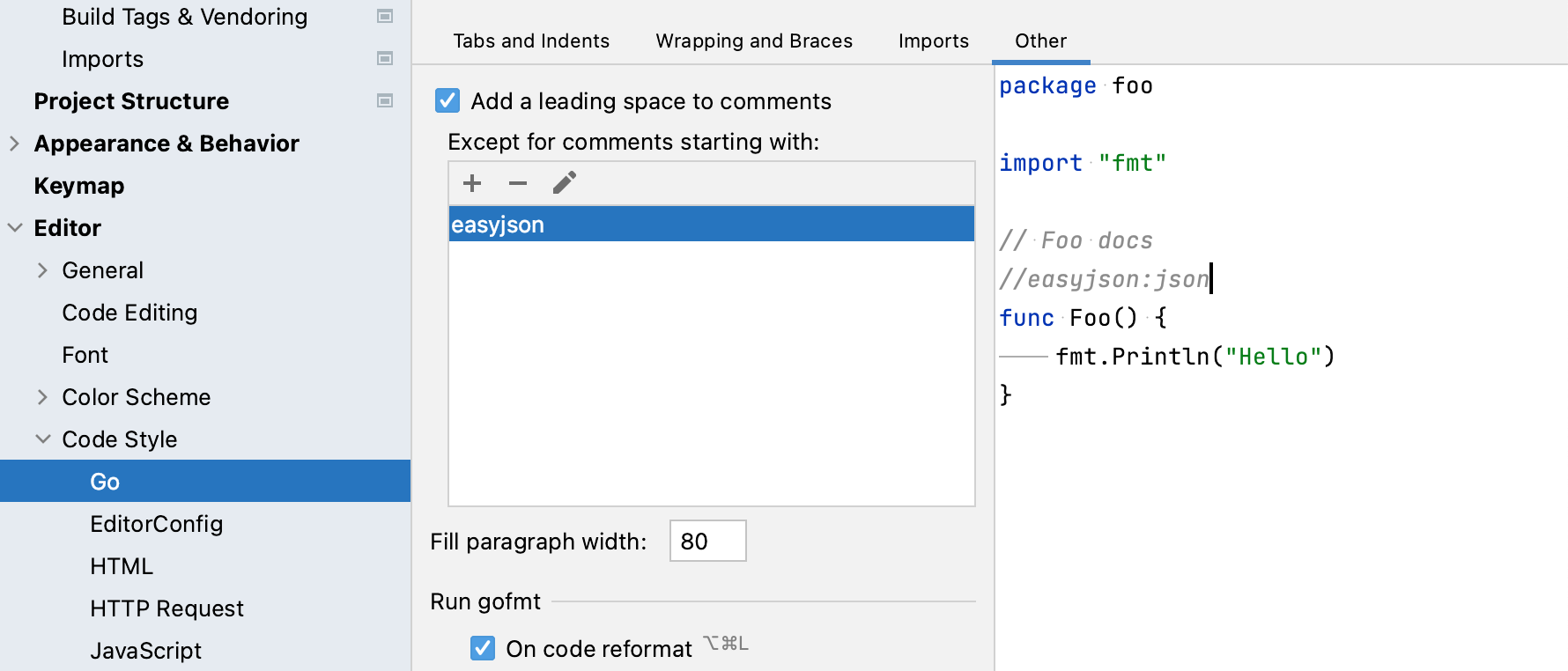Reformat and rearrange code
GoLand lets you reformat your code according to the requirements you've specified in your current code style scheme or the .editorconfig file. If anything is not defined in .editorconfig, it is taken from the project settings.
You can reformat a part of code, the whole file, group of files, a directory, and a module. You can also exclude part of code or some files from the reformatting.
Reformat a code fragment
In the editor, select a code fragment you want to reformat.
Before reformatting, you can take a look at the code style settings that are applied to the selected code: press Alt+Enter and click Adjust code style settings.
In the main menu, go to or press Ctrl+Alt+L.
Reformat a file
Either open your file in the editor and press Ctrl+Alt+Shift+L or in the Project tool window, right-click the file and select .
In the Reformat File dialog that opens, if you need, select the following reformatting options:
Optimize imports: select this option if you want to remove unused imports, add missing ones, or organize import statements.
Code cleanup: select this option to run the code cleanup inspections.
Do not keep line breaks: reformat line breaks according to the code style settings. This option overrides the setting.
Click Run.
If you want to see the exact changes made to your code during the reformatting, use the Local History feature.
Reformat line indents
You can reformat line indents based on the specified settings.
While in the editor, select the necessary code fragment and press Ctrl+Alt+I.
If you need to adjust indentation settings, in the Settings dialog (Ctrl+Alt+S) , go to . Select the language for which you want to change indentation.
On the Tabs and Indents tab, specify the appropriate indents options and click OK.
Automatically reformat code on save
You can configure the IDE to reformat code in modified files automatically when your changes are saved.
Press Ctrl+Alt+S to open the IDE settings and then select .
Enable the Reformat code option.
Additionally, you can configure the way the IDE will reformat your code:
Click Configure scope to specify the patterns of filenames and directories that you want to exclude from reformatting.
From the All file types list, select the types of files in which you want to reformat code.
Select Whole file or Changed lines if your project is under version control.
If you select Changed lines, reformatting will apply only to the lines of code that have been changed locally, but not yet checked in to the repository.
Exclude files from reformatting
You can exclude a group of files and directories from reformatting and import optimization.
In the Settings dialog (Ctrl+Alt+S) , go to .
Switch to the Formatter tab and in the Do not format field, enter the files and directories that you want to exclude using a glob pattern.
You can specify several glob patterns separated with a semicolon
;. If you click, the field will expand, and each pattern will be shown on a separate line.
Apply the changes and close the dialog.

Exclude code fragments from reformatting in the editor
In the Settings dialog (Ctrl+Alt+S) , go to .
Switch to the Formatter tab and enable the Turn formatter on/off with markers in code comments option.
In the editor, at the beginning of a region that you want to exclude, create a line comment Ctrl+/ and type
@formatter:off. At the end of the region, create another line comment and type@formatter:on.The code between the markers won't be reformatted.
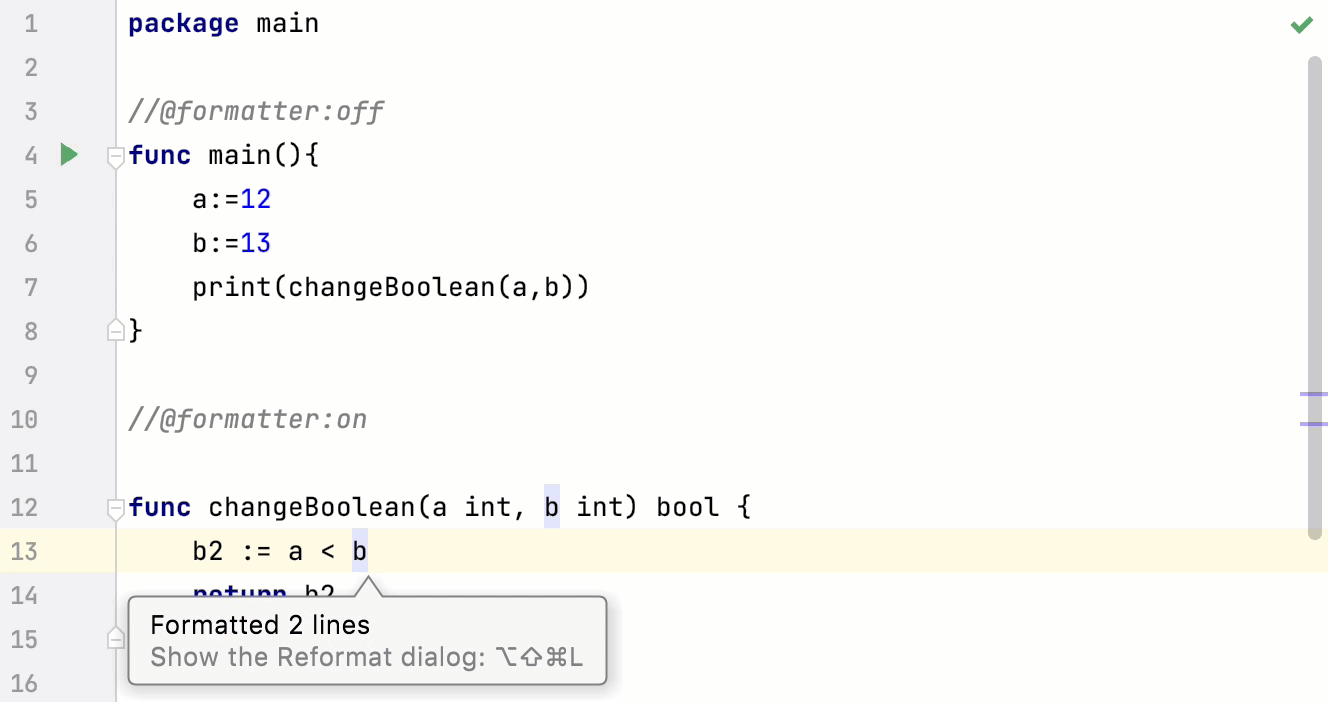
Reformatting with the gofmt tool
Comparing to the gofmt tool, GoLand’s formatter works with syntactically incorrect code and can be invoked on an arbitrary block. Also, the built-in formatter can automatically insert semicolons and wrap parameters and arguments.
If you want to use the gofmt anyway, you can use the following tools:
Go tools: click and select Go Fmt File (to run gofmt in the current file) or Go Fmt Project (to run gofmt for the current project).
The Before Сommit section: run the gofmt tool before you commit your changes.
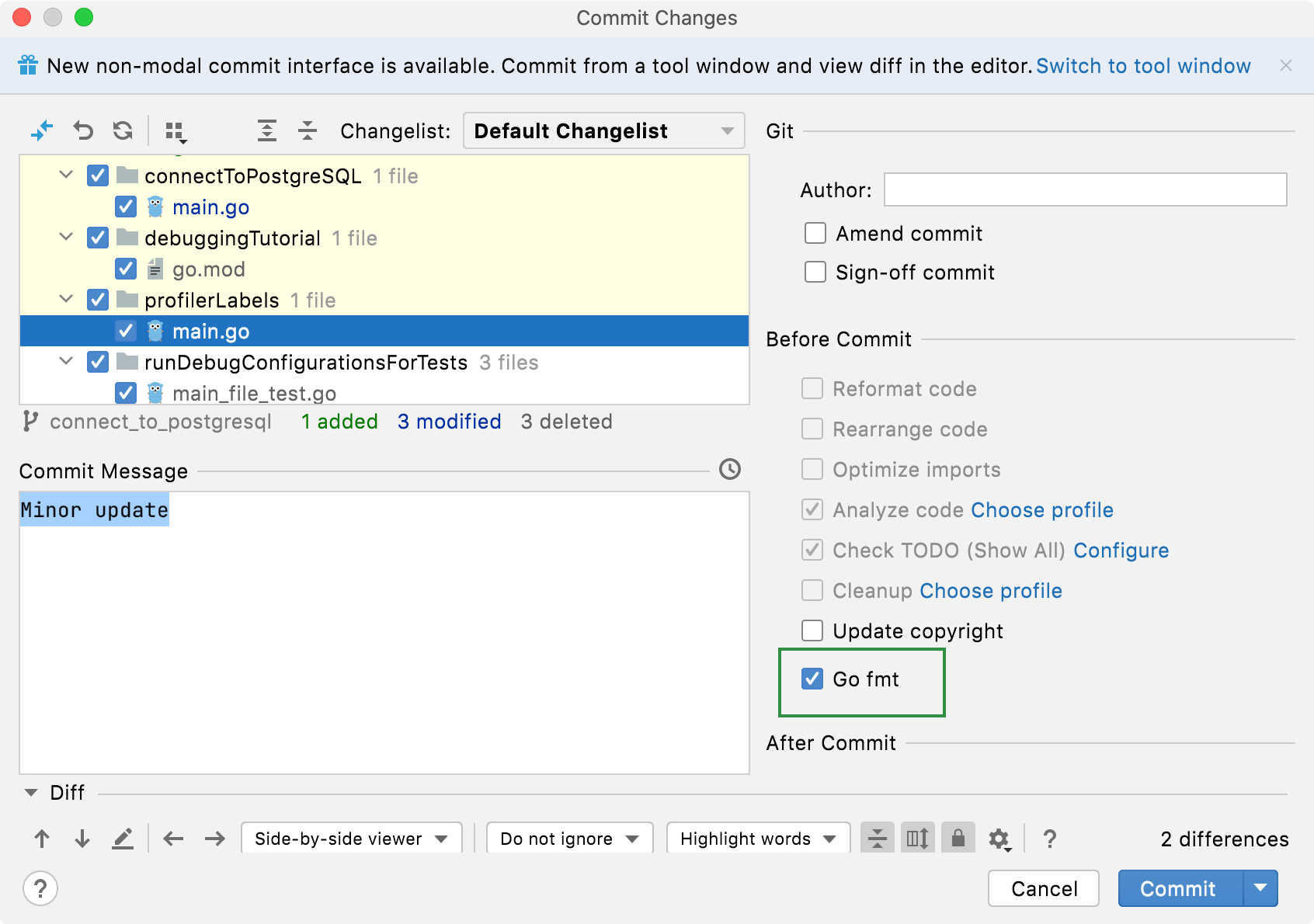
File Watchers: to set a file watcher to run the gofmt tool, open settings by pressing Ctrl+Alt+S and navigate to . , click the Add button and select go fmt. In the New Watcher dialog, click OK.
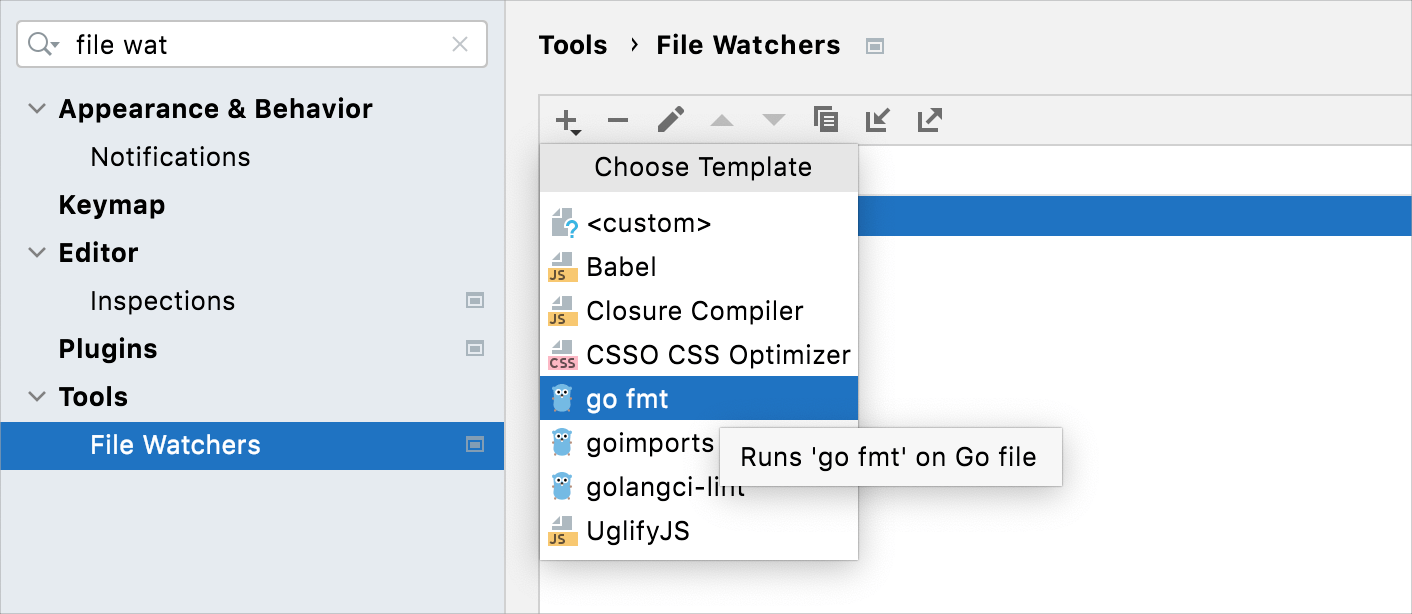
By using the following option, you can run the gofmt tool each time you use the reformat action. For example, GoLand will run the gofmt tool each time you press Ctrl+Alt+L.
Run the gofmt tool after the reformat action
You can run the gofmt tool each time you reformat your code (for example, by pressing Ctrl+Alt+L). The first pass is made by the built-in GoLand formatter and then by gofmt.
To enable this feature, open settings by pressing Ctrl+Alt+S and navigate to . . Click the Other tab and select On Reformat Code action checkbox.
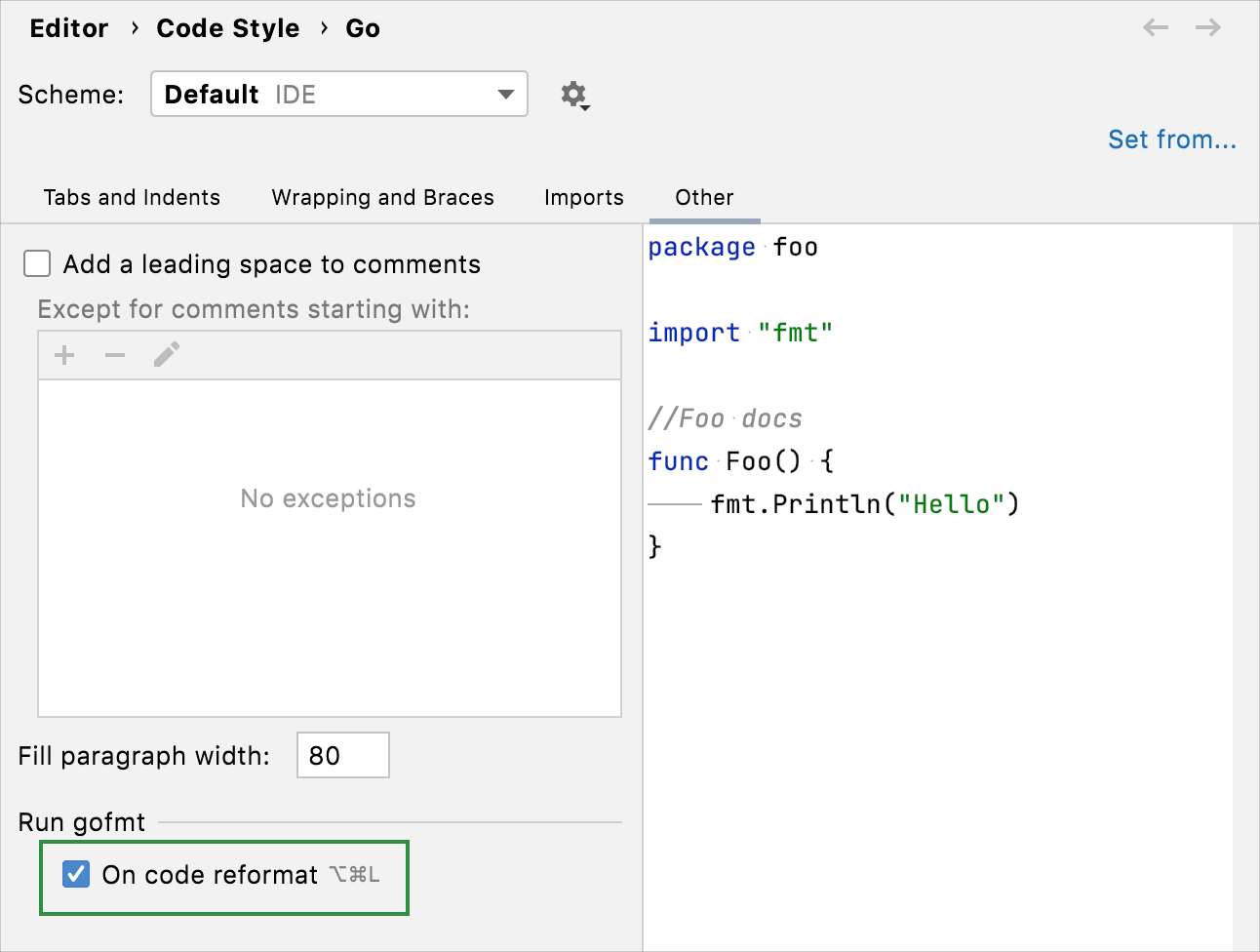
Configure leading spaces in comments
After you applied the Reformat Code action Ctrl+Alt+L, GoLand may add leading spaces before the comment text.
Before | After |
|---|---|
//easyjson:json
|
// easyjson:json
|
In Go, comments are also used as annotations. In some libraries, spaces between comment markers and annotation instructions are not processed correctly. In the previous example, easyjson:json is an annotation.
You can disable leading spaces for annotations that start with certain prefixes.
Open the Settings window ().
Click .
Click the Other tab.
Select the Add leading space to comments checkbox.
In the Except for space to comments field, click the Add icon (
).
Type the prefix name that you want to add as an exception (for example,
easyjson).Click OK.
